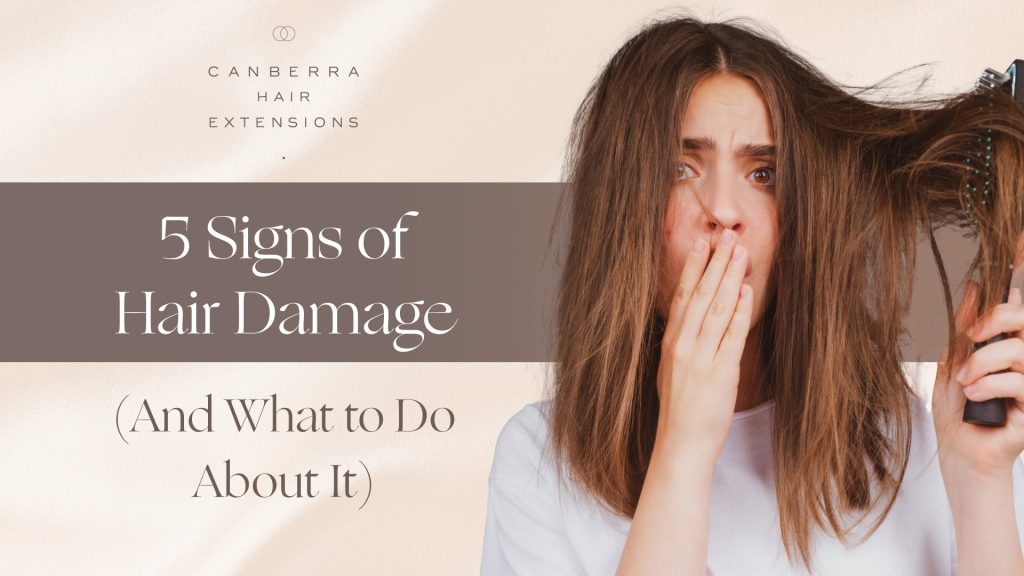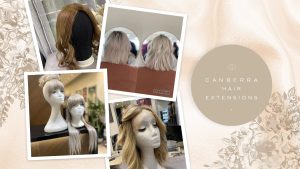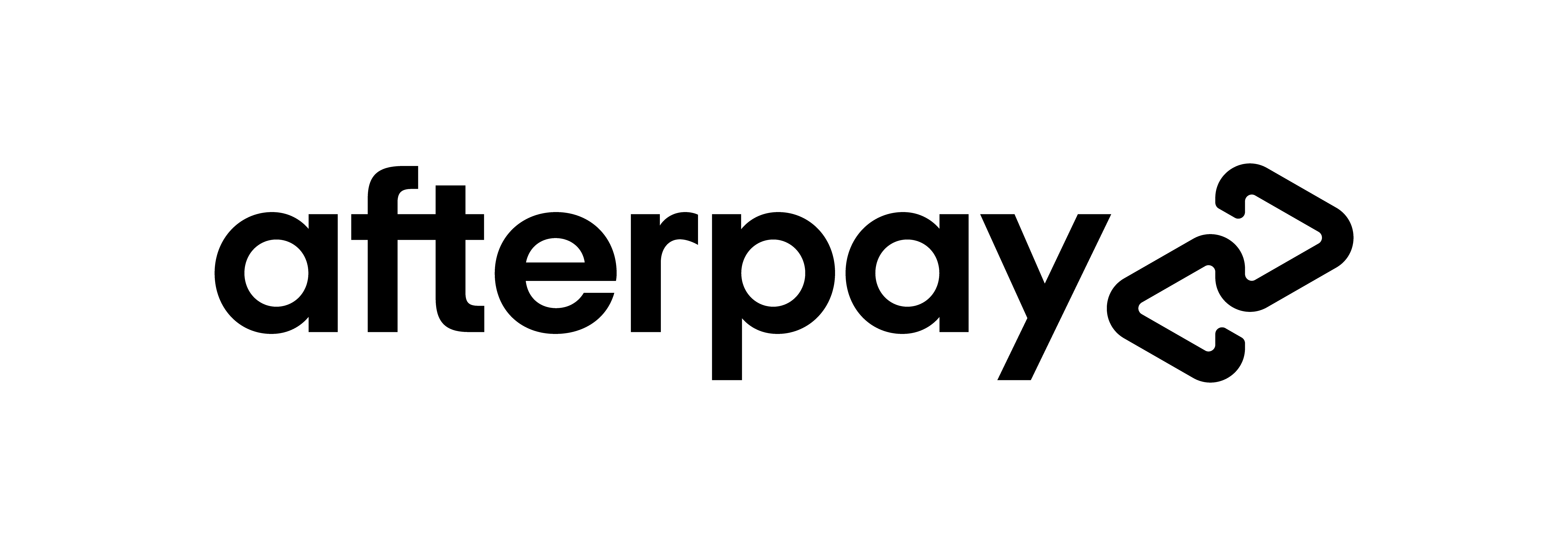Wondering, “Is my hair damaged?” is a common concern many of us face, and often, it’s a valid one. From dullness to hair breakage, damaged hair can manifest in various ways and be caused by an array of factors. But worry not, because help is at hand. At Canberra Hair Extensions, your go-to hair salon in Dickson, we’re determined to turn your hair damage woes into a journey towards healthier, shinier locks.
In this article, we aim to arm you with all the necessary knowledge to identify hair damage, understand its root causes, and learn how to treat and prevent it. By the end of this read, you’ll have all the tools you need to transform your hair from a tangled travesty to a show-stopping shine factory.

Why care about hair damage?
Hair, primarily composed of a protein named keratin, isn’t a vital organ but plays an essential role in our overall appearance and self-confidence. Hair damage, which disrupts the hair shaft’s integrity, results in dull, brittle strands that can impact our self-image negatively. Moreover, it could potentially signal underlying health issues or nutritional deficiencies.
Therefore, taking care of your hair’s health isn’t just about aesthetic appeal; it also functions as an early detection system for other health-related matters.
5 signs of hair damage
While some of the signs of hair damage can be sneaky and varied, there are a few telltale indicators that your mane might be crying out for a little extra care. You can explore some of them below:
1. Dull and lacklustre look
When your hair lacks its usual lustre, it’s often an indication of hair damage. Healthy hair has a natural shine, thanks to the oils produced by your scalp. So, if your hair appears dull or dry, it may be a sign that it’s not getting the nourishment it needs. Sometimes, lacklustre hair can make your overall appearance seem tired and aged, so it’s worth giving it the attention it deserves.
2. Brittleness and easy breakage
Healthy hair has a certain elasticity to it. If your hair breaks with the slightest tension, it’s a clear sign of damage. Damaged hair becomes brittle and thin, often breaking off more easily and causing unwanted split ends. Besides, constant breakage can lead to a thin appearance of your hair, depriving it of the volume and density that signify health and vitality.
3. Difficulty with styling
If styling your hair becomes more of a challenge than a joy, it might be a sign of hair damage. Healthy hair responds well to styling and usually maintains its form for a while. Damaged hair, on the other hand, can appear frizzy and unmanageable, regardless of the amount of effort you put into styling it. Furthermore, the endless fight against unmanageable hair can lead to more stress and frustration, diminishing the joy of flaunting your favourite hairstyles.
4. Slow growth and rapid colour fade
Hair damage often slows down the growth rate of your hair. You might notice that your hair isn’t growing as quickly as it should or that your dyed hair colour fades rapidly. This could be a sign that your hair is not retaining nutrients effectively. This stagnation in growth and colour vibrancy can significantly limit your options for experimenting with new hairstyles or colours, limiting your style expression.
5. Constant flyaways and split ends
One of the most visible signs of hair damage is the presence of numerous split ends. If you notice an abundance of frizzy flyaways or split ends, it’s a clear sign your hair could use some additional nourishment. The ends of our hair are the oldest and most vulnerable part of our strands, so they’re often the first to show signs of damage.

Common cause of hair damage
Hair damage can be the result of a multitude of factors, often stemming from both external and internal influences. External causes commonly include physical and environmental stressors. For example, habitual use of heat-styling tools like straighteners, curlers, and hair dryers can lead to excessive dryness and brittleness. Similarly, frequent chemical treatments such as colouring, perming, or relaxing can weaken the hair structure, making it prone to breakage. Environmental factors like excessive sun exposure, the presence of chlorine in swimming pools or salt from seawater, can also lead to hair damage.
Internally, your lifestyle choices significantly affect the health of your hair. A diet lacking essential nutrients can deprive your hair of the nourishment it needs to stay strong and healthy. Additionally, factors like high-stress levels, inadequate sleep, smoking, and excessive alcohol consumption can all contribute to hair damage. Even certain stages in life, such as pregnancy, postnatal, perimenopause, and menopause, due to hormonal changes, can affect the state of your hair.

Effective ways to repair and prevent hair damage
Every challenge presents an opportunity for improvement. Hair damage is no different. With the right knowledge and approach, you can not only repair existing damage but also prevent further harm. Follow these practical steps below to help rejuvenate your hair and reclaim its health and vitality:
- Invest in high-quality haircare products: Swap your standard haircare products for professional-grade ones. They’re specifically formulated to nourish your hair and protect it from damage. What you put on your hair matters, so choose wisely.
- Protect your hair from heat and environmental damage: Limit the use of heat styling tools and always use a heat protectant when you do use them. Protect your hair from harmful UV rays, saltwater, and chlorine by wearing a hat or using a hair mask when you’re out in the sun or swimming.
- Maintain a healthy diet: Good hair health starts from within. Ensure you’re getting enough protein, vitamins, and essential fatty acids in your diet.
- Stay hydrated: Water is vital for overall health, including your hair health. It helps keep your hair hydrated from the inside out, enhancing its texture and making it less prone to hair breakage.
- Regular trims: Get regular trims to get rid of split ends and keep your hair looking healthy and fresh. It’s a simple and effective way to maintain the health of your hair.
- Develop a regular hair care routine: Establish a routine that includes shampooing and deep conditioning your hair. Stick to it and your hair will thank you.
- Visit your hairdresser regularly: Maintain a consistent relationship with your hairdresser. They can help you understand your hair’s unique needs and recommend a personalised hair care regimen. Plus, they can monitor your hair’s health over time and adjust treatments as needed.
Remember, repairing and preventing hair damage is a process. Consistency and patience are key. But with the right care and attention, you can restore your hair’s health and keep it looking its best for years to come.
Ready to transform your hair from damaged to dazzling?
Armed with the knowledge of signs of hair damage and effective ways to repair and prevent it, you’re now well-equipped to reclaim the health and vibrancy of your hair. Hair damage may be a common issue, but it doesn’t have to be a permanent one. At Canberra Hair Extensions, we’re committed to guiding you on your journey to healthier hair, every step of the way.
Remember, recognising the problem is the first step in resolving it. So if you’ve identified these signs of damage in your own hair, don’t wait for the problem to escalate. Take control of your hair’s health today. Make an appointment with our expert stylists at Canberra Hair Extensions, your trusted hair salon in Dickson.






